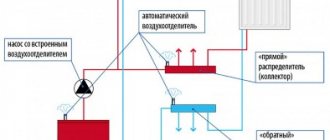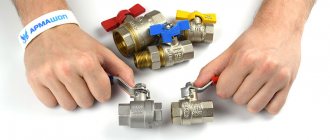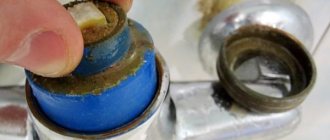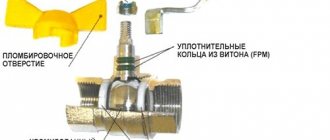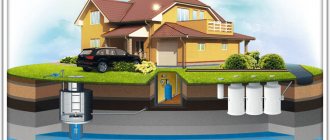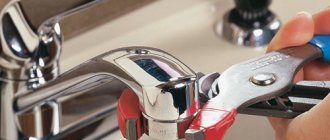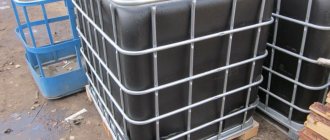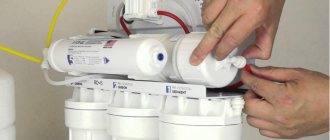Types of water valves
The following types of water valves are available:
- valve;
- ball
The principle of operation of a valve valve is to shut off the water using a gasket mounted on the stem.
The main advantages of the valve valve are:
- the ability to control water flow;
- the ability to carry out repairs yourself.
The disadvantages of valve valves include:
- fragility of the device. The gasket, which acts as a lock, comes into contact not only with water, but also with the metal body of the valve, which leads to increased natural wear;
- difficulty using the device. To completely block the flow, it is necessary to make several revolutions with the control flywheel.
Ball valves shut off the water thanks to a shut-off mechanism made in the shape of a ball. When the control lever is turned, the hole in the ball turns over perpendicular to the fluid flow.
The advantages of ball valves include:
- simplicity of the device, which guarantees a long period of use;
- complete tightness in the closed position;
- ease of use. To completely shut off the water, you must turn the control knob 90º.
The disadvantages of ball valves are:
- impossibility of limiting the flow (exclusively complete overlap);
- impossibility of carrying out routine repairs. If the device no longer performs its functions, a complete replacement will be required.
To completely shut off the flow of water, it is more advisable to install ball valves. If you need to regulate the water flow, it is better to install a valve valve.
By design, the water valve can be:
- passable. A straight-through valve allows water to flow in a certain direction and serves to shut off the flow. Installed exclusively on a flat section of water supply;
- direct-flow. A type of straight-through valve with less hydraulic resistance;
- corner. The valve is installed on the corner pipe connection. The incoming flow is perpendicular to the outgoing flow.
Design and principle of operation
A ball valve consists of a body, a spherical-shaped shut-off element (plug), mounted on a rod (perpendicular to the axis of movement of the medium). The locking element has a round hole for the passage of the medium. The locking element (plug, valve) and seat are sealed with fluoroplastic or synthetic rubber. The rod (spindle) is turned by a handle.
To completely shut off the pipeline, it is enough to turn the handle that rotates the rod 90°. In this case, the ball-shaped valve rotates and its solid side reliably and hermetically blocks the flow of the medium. When the handle is opened, the valve rotates so that the axis of the through hole in the valve coincides with the axis of the pipeline and the liquid moves freely through the valve.
The design features of the ball valve make it possible to shut off the flow of the medium very easily and quickly, especially in comparison with gate valves and valves. Therefore, previously popular valves (valves), which had to be turned for a long time to shut off the flow, are becoming a thing of the past, and lever mixers are already installed in every apartment.
Types of locking elements
Today there are 2 main types of water taps and valves:
- ball;
- valve
Simplicity of design and ease of use have made this fittings in demand among consumers. It has an acceptable service life and is widely used as a shut-off valve not only in water supply systems, but also in gas networks.
The design of this device does not allow it to be used to regulate fluid flow. The main disadvantage of the ball valve is considered to be complete non-repairability.
Due to their design features, valve fittings have a short service life, since sealing elements made of leather or rubber quickly fail. However, it is possible to replace them, which extends the operating time without compromising performance.
Depending on the method of fastening the valves, the corresponding fasteners are used. In domestic systems, a coupling connection (American) or squeegees are most often used, and in industry, on high-pressure pipelines that do not allow leakage of working media, the fittings are installed by welding.
Difficulties of winter water supply
Being at the dacha or living in a private house, sooner or later every person is faced with the need to use a water hose on the street. For example, the garden is being watered, a small skating rink in the garden area may be filled in winter, or a car may be washed in an open area. Of course, you can constantly go home and carry water in buckets, but this is not very convenient and does not allow you to take advantage of all the benefits of your own autonomous water supply.
An effective solution to this problem will be a non-freezing outdoor faucet, which has a fairly simple design. This is a reliable locking element, the installation and subsequent use of which does not present any particular difficulty. Depending on their type, size and design, such hydrants can be made exclusively for street use or require a combined installation, when part of the structure with the locking mechanism is kept warm in the house, and the valve with the spout is located directly on the street.
Water tap installation
1) Water tap with one valve. They are distinguished by the simplicity of their design and have the quality of reliability during operation. These devices can be used in cold and hot water taps.
The bodies of such taps are made of brass or copper. The water retention mechanism has the form of a ceramic or worm-type axle-box faucet.
In worm-type devices, the basic rule of reciprocating movement is applied. The main and most common breakdown of such taps is the failure of the rubber gasket, which can easily be replaced.
A ceramic water faucet consists of plates. One of them is rigidly fixed, and the other rotates under the action of the valve. The taps have the property of long-term performance and, thanks to the high resistance of ceramics to abrasion. In addition, these devices are more expensive than worm-type devices. The spout is often cast as one block with the body.
Devices with one valve allow you to control only one type of water supply, either hot or cold.
2) Two-valve devices. For these mixers, axle-box taps are used, controlled by two valves. Each type of water passes through separate retention mechanisms.
Repairing these devices sometimes also involves replacing the gasket, but in some cases it is necessary to replace the crane axle box.
These types of faucets are quite commonly used in kitchens and bathroom vanities. To use them directly in the bathroom, another hole is required to connect the shower hose. The entire structure of the device is complemented by another switch to regulate water flows.
3) Single lever devices. They are easy to use and are a type of ball mixer. The main element in the structure of this mixer is the cartridge, which can perform movements in all directions. To control it, a lever is used to regulate the volume of water supply, as well as its temperature. The cartridge has three holes, two of which receive hot and cold water, and the third hole allows water to flow to the spout in a mixed form and at the desired temperature.
The device body has a metal thickness of more than 2 mm and can be repaired at home. It consists of replacing a damaged cartridge by disassembling the device itself
In this case, you should pay attention to the fact that cartridge models are different, so when purchasing a new version, you need to compare it with the used device. Also, when removing a cartridge, you must remember its location in the case in order to subsequently correctly install the new device
4) Devices with a thermostat. The development of innovative technologies allows us to improve the use of mixers for convenience and simplicity. Recently, devices with thermostats have become popular models. A significant difference from standard mixers is the presence of a thermal element in it, which performs the function of regulating water flows when bringing it to the required temperature. A special handle is installed in the outer part, allowing you to set the desired water temperature. Its flow to the spout is regulated by a separate lever. These devices are quite convenient to use when only the water supply pressure is regulated, while its temperature is set in advance.
5) Touch devices. This type of tap has found its application in sanitary facilities of large organizations. The mixer is equipped with a special photocell that turns on the water supply when you bring your hands to the tap, and stops supplying it after removing your hands from the tap. The device is cost-effective and meets all hygienic standards. The water temperature and its pressure are regulated by a special installed rod located on the mixer body. There are models in which the temperature is set using a remote control that provides control of water heating, as well as using a temperature sensor located in the body structure of the faucet. In this case, the device is equipped with an electronic controlled unit.
Touch devices are most often used in organizations with a large number of visitors.
How to change the cartridge in a bathroom faucet?
Why do you need an aerator in the mixer?
How to install a faucet on a sink?
Where are plastic ball valves used for water supply?
Polyethylene valves are suitable for installation on HDPE pipes and are used in drinking water supply systems, irrigation systems, when supplying water to a swimming pool, etc.
The polyethylene valve is mounted on a PVC pipe using a compression coupling without the use of special tools, and this work does not require special skills.
The shut-off device of such a faucet is a plastic ball that is resistant to negative temperatures, something that steel or brass counterparts cannot boast of. Also, the plastic ball valve is not subject to corrosion, does not collect various deposits and practically does not break.
However, plastic taps are not resistant to high temperatures, so the maximum temperature of passing water should not exceed +45 °C. Working pressure can reach up to 16 atm.
The service life of a plastic water faucet is 15 years or more, provided that no parts (for example, the gland seal) were damaged during installation. Moreover, if there is a need to disassemble the water supply system, the crimping device will allow this to be done as many times as necessary.
Polyethylene ball valves for water supply come in the following sizes:
- 20 mm;
- 25 mm;
- 32 mm;
- 40 mm;
- 50 mm;
- 63 mm.
The thread sizes of these devices range from ½ to 2 inches, and can be either external or internal.
How to choose a ball valve?
The following selection criteria should be followed:
- Material of manufacture and appearance of the case
. The preferred option is a product made of brass or stainless steel. A silumin faucet is cheaper, but it is fragile and requires careful handling. - Material for making the sphere
. The locking element must have a mirror-like and absolutely smooth surface. It would be good if it was coated with nickel or chromium. A cloudy sheen or matte finish is not welcome. - Body markings
. A three-way ball valve must contain information about the manufacturing company, nominal diameter and operating pressure. Letters and numbers must be clear and clearly visible, otherwise you may suspect a fake. - Maximum permissible pressure
. It should be selected taking into account the characteristics of the engineering system. At the same time, you need to choose a ball valve with an American one with a reserve. That is, the pressure indicated on it must be higher than that used in communications. - Product weight
. A brass product is always heavier than a steel or silumin counterpart. - Handle shape
. On sale you can find products with a long lever or “butterfly”. The first option is more preferable in situations where the tap has not been turned for a long time. Then you have to make an effort to do this, which in the case of the “butterfly” is problematic. - Price
. Everyone decides this question for themselves, but high-quality products cannot be cheap. - Correspondence of the listed characteristics to the peculiarities of life in this particular country
. In different cities, the temperature of water in heating systems varies, which leaves its mark on the choice of shut-off valves.
Ball valve handle
As already mentioned, it can look like:
- Lever
. A ball valve with an American connection of this type is more practical and easy to use. It allows you to grab it with your whole hand and turn it in the desired direction. If the faucet is “sour”, then this requires considerable effort, but with a lever this is easier to do. - Butterflies
. More preferable from an aesthetic point of view. It is neat in appearance, but to turn it, only two fingers of one hand are used, which will be difficult to move the “stuck” faucet.
It must be said that the pen can have a variety of colors. Traditionally, blue is used for cold water supply systems, and red for hot water supply systems. Handles designed for gas pipelines are produced in a yellow version. In addition, you can find white products on sale - they are specially installed on radiators and heated towel rails. The manufacturing material can be either plastic or metal.
What materials are ball valves for water supply made from?
To manufacture modern ball valves for water supply, steel, brass, polyethylene and a number of other materials are used. For example, if we compare a faucet made of silumin with a faucet made of brass, we will find that the first one is much lighter. You should not give preference to a silumin faucet, since this material is very fragile and such a faucet will not last long. When choosing a device, it is worth considering which ball valve will be better for the water supply.
Brass ball valves
The best ball valves for domestic plumbing are made of brass. They are produced in two ways:
- casting in molds;
- forging with a mechanical press.
At the same time, forged cranes will be more reliable and, therefore, more expensive. Higher reliability of forged ball valves for water supply is ensured by the fact that during forging the number of air cavities in the body is reduced to a minimum.
Since brass includes some components with different electrochemical potentials, it is coated with a protective layer to prevent corrosion.
It is important to remember that brass ball valves should not be used where the temperature of the working material in the pipeline exceeds +150 °C. At such temperatures and above, microcavities begin to form in brass, which increases its fragility and reduces the reliability of the tap.
Steel devices
Steel ball valves are widely used in industrial pipelines. Due to their strength, steel ball valves can pass extremely hot liquids and even steam. Also, this type of ball valve can work in systems with high pressure or pressure.
Plastic ball valves for water supply
Ball valves for water supply of this type are made of polypropylene or polyethylene of various modifications. These materials are immune to chemical, oxygen and electrochemical corrosion, which makes them indispensable in pipelines through which aggressive liquids are supplied.
But polymer ball valves have disadvantages, the main one of which is instability to high temperatures. Therefore, plastic ball valves are not suitable for use in heating systems and hot water pipes.
Read material on the topic: Ball valves wholesale: criteria for choosing a product and supplier
How to install a brass ball valve
The use of ball valves can significantly simplify the process of repair and maintenance work. Installation of ball valves involves shutting off the flow of water on the riser of an apartment building, so before installing them, you must ensure that you have permission from the relevant authorities. Installation of a brass ball valve can be done independently. To do this, prepare the required materials and tools. The list of such tools is small:
- adjustable wrench (or gas wrench);
- FUM tape (for sealing joints).
Some recommendations for installing a brass ball valve for installing it yourself will help you complete the work as quickly and efficiently as possible:
- Before replacing the ball mechanism, it is worth turning off the flow of water and draining its remains from the water supply system. When carrying out work indoors, there must be a container for draining water at the place where the fittings are dismantled.
- The installation of a ball valve should be done in those places of the water supply system to which there will be unhindered access to the rotary valve.
- In addition to convenience, the installation location is also affected by the markings on the product. The direction of the arrow must coincide with the direction of water flow along the main line, otherwise the system will not be able to operate as planned.
When purchasing, be sure to pay attention to the thread type of the brass ball valve. Based on its location on the body, taps are divided into several types:
- with an external type of thread cut on both sides of the tap;
- with internal threads cut on both sides of the tap;
- with internal thread on one side and external thread on the other;
- with internal thread on one side and “American” on the other.
The main purpose of a brass ball valve is the role of shut-off valves in water supply and sewerage systems.
Using FUM tape or linen twine, it is necessary to control that the direction of their twisting coincides with the direction of the thread of the valve body. Upon completion of installation, you must make sure that the tap handle can be easily turned.
Turning the tap too easily along its axis while screwing it onto the pipe indicates the need to add FUM tape or twine. Twisting should take place with little effort. You shouldn’t be overzealous either, since the body may not be able to withstand it and burst.
Read material on the topic: Ball valves for water: types, application, choice
Why choose brass ball valves for plumbing
Brass ball valves are well suited for domestic use. If you are interested in purchasing a faucet for a long time, then you should pay attention to products from well-known brands.
Ball valves for plumbing, the price of which is above average, are really good quality products. In the field of manufacturing ball valves for water supply, there is very tough competition, so manufacturers are interested in real improvement of their products. Serious companies carefully monitor the quality of finished products and value their reputation. Unlike counterfeits from China, high-quality ball valves for water supply are made of forged brass, the chemical composition of which meets the necessary European standards. These standards prescribe that brass contains metals in certain proportions, namely:
- copper – 55–60%;
- lead no more than 2.2% (this metal is needed for hardness);
- zinc – 40%.
You should be wary of unscrupulous manufacturers who skimp on materials. They may increase the lead content to 7% to make the product heavier. But such a move will be harmful to the buyer’s health, since the high lead content in water causes severe harm to the body. Or there may be another way - to use only zinc or silumin, which will make the ball valve body fragile and unreliable.
A good quality water supply ball valve consists of the following parts:
- body made of hot-pressed brass, the wall thickness of which is at least 2 mm;
- perforated ball valve made of polished brass;
- ergonomic butterfly handle or lever handle;
- adjusting or housing nut;
- Teflon connection seal;
- sealing washer;
- rod with rubber seal;
- the rod itself is made of brass and is located inside the body.
The ball valve for water supply can be combined
or
coupling
.
The coupling valve has the following characteristics:
- diameter ranging from half an inch to four inches. One-inch taps are used to connect risers in apartment buildings and for installing pumping stations, and half-inch taps are used to connect water meters and household appliances;
- The type of thread of such a tap can be internal-internal, external-external and internal-external;
- working pressure is not less than 16 atm. (PN16)-40;
- maximum permissible temperature of the working environment is +200 °C.
Coupled ball valves for water supply are compact, easy to install and operate.
The combination tap differs in the number of pipes:
- an angle faucet with a half-inch external thread on both sides is used when connecting plumbing fixtures;
- corner tap with ½ and ¾ inch external thread is used to connect the washing machine;
- A three-way ball valve for water supply with a thread of ⅟4 and ¾ inches is also used for installing washing machines and other plumbing fixtures, and is also capable of protecting equipment from water hammer if it has not been in use for a long time.
Combination ball valves for water supply are made of nickel-plated brass and equipped with a compact handle. All this makes such a faucet well suited for installation in a bathroom where a designer renovation has been carried out. The connection is made using a flexible hose with union nuts.
This type of ball valve is suitable for installation on hot and cold water supply systems, since its operating temperature range is from -10 °C to +90 °C. The maximum operating pressure in the supply pipe can be no more than 10 bar.
The number of opening-closing cycles is 4,000 times.
Read material on the topic: Angle valves for radiators: types, advantages and installation
A little history
They were familiar with centralized water supply in ancient Egypt, Hellas, and the Roman Empire. Roman aqueducts still exist in Italy, Spain and Germany.
Some of them are still used today for their intended purpose. Such a mass of water flowing into ancient cities had to be managed. This is how the first samples of shut-off and water fittings appeared. On the island of Capri, archaeologists discovered ancient brass and bronze cork valves. These are the world's very first models of shut-off valves, predecessors of valves, ball and water taps.
The next impetus for the rapid development of gates and valves was the invention of the steam engine. The need to control water supply and control steam has led to the development of reliable gate valves and adjustable spring-loaded safety valves.
Some technical solutions have not lost their relevance in our time. In the twentieth century, utility networks began to be equipped with butterfly valves, diaphragm valves and ball valves. Today, the development of shut-off valves is moving in several main directions:
- durability;
- reliability;
- manufacturability;
- cost reduction.
Single valve taps
This is the most famous type of valve taps. The main distinguishing features of these devices are the simple design of the valve and relatively high reliability indicators. Such models are used exclusively as shut-off valves for cold or hot water supply separately. Basically, water taps and valves are made of copper or brass. Single-valve faucets have a locking mechanism called a faucet axle. Based on the operating principle, the following types are distinguished: worm and ceramic.
The crane axle box with a worm mechanism is based on a rod. By making rotational movements on the water valve, the worm rod lowers and rises. During forward movement on the valve wing, the rod presses the gasket to the middle of the body, where a kind of “saddle” is located. A common cause of problems with single-leg faucets is wear of the gasket. Water leaks through it even in the closed position, and therefore water constantly drips from the spout. To fix the damage, you need to replace the leaky gasket with a new one. You can buy it in a specialized store or cut it out of thick rubber with your own hands.
Device . Their mechanism consists of two closely spaced plates with a small gap on the body of the part. One half is fixed in the body. The second flap moves with the help of a valve. With the plates in the same position, water flows freely through the tap into the spout. Valves with this mechanism rarely break. Another undoubted advantage is the resistance of ceramics to wear. Although more expensive than models with a worm rod, they are much more reliable and durable.
However, not everything is so smooth. Ceramic spouts are generally manufactured in the form of a single body. Therefore, turning the spout from side to side will not work. Let's return to the type of valve taps - axle-box valves with a worm rod. In such faucets, the spout is made in the form of a tube. It is built into the housing and tightened with a lock nut. The spout can be rotated left or right and fixed in the desired position.
When choosing between steel and brass, it is better to give preference to models made from the latter material. Brass taps and mixers are highly resistant to corrosion.
Types and designs
First of all, water taps are classified according to their purpose:
- For domestic needs - mixing and valve type taps.
- For household and municipal needs - water intake, irrigation, etc.
- To adjust the water supply - technical (coupling).
Based on the direction of flow, tap devices are divided into:
- pass-through (standard), which does not change the movement of the carrier;
- angular (rotary);
- three-way (mixers, tees).
According to the shutter configuration there are:
Ball (cartridge).
The valve is a ball with a round through hole through which water is supplied when the ball is turned 90⁰, the reverse movement blocks the flow. Depending on the diameter of the bore, the ball valve can be floating (for small diameters) or supporting.
They are characterized by low hydraulic losses, reliable tightness and easy control.
Conical (cork).
The locking element is made in the shape of a cone (plug), sometimes with a trapezoidal passage hole. Depending on the device, the plugs open and close either by raising/lowering the shutter, or by rotating it around its axis. Depending on the method of sealing, there are gland seals and tension seals.
The disadvantage of the design is the need for regular lubrication of the bolt mechanism, because over time, it sticks to the body, which complicates the operation of the faucet and leads to loss of tightness and rapid wear.
Cylindrical.
The valve is made in the form of a cylinder, the movement of which opens or closes the tap.
The drawback is the lack of complete tightness, which is why taps of this type are used primarily to regulate the intensity of flow.
Based on the type of design solution, mixers are divided into:
Single valve.
The simplest and, today, outdated design. They are not intended for mixing water flows supplied from different pipes, because... installed on the principle of one faucet - one pipe. The reciprocating movement of the valve activates the axle box built into the housing, opening and closing the device.
Crane mechanisms of this type are now found, perhaps, only in dachas, in old apartments, in irrigation or heating systems, when a faucet is installed on the radiator to drain the coolant.
Two-valve.
A modern solution that simultaneously supplies water and mixes flows supplied from two different pipes, and regulates the pressure and temperature of the medium by simultaneously opening one or two valves.
Single lever.
Raising the lever activates the locking and adjustment mechanism, the role of which is performed by a three-way ball valve. It mixes cold and hot water flows and gives the consumer the desired temperature.
By type of control of the crane mechanism:
- manual (valve and lever);
- electrical;
- pneumatic;
- hydraulic.
A separate group includes models with a thermostat and touch sensors:
With built-in thermostat.
Innovation in the world of plumbing. Built-in software and thermostat regulate both temperature and water flow. The control panel can be mechanical or electronic. The power supply can be powered by batteries or a rechargeable battery.
Plus - economical water consumption. The downside is the high cost of both the crane itself and its repair in the event of a breakdown.
Touch (non-contact).
The tap is pre-programmed to dispense water at a certain pressure and temperature. Control is carried out automatically by means of an opening or closing command coming from the built-in infrared touch sensor.
Due to the complexity of constant adjustment, sensor faucets are practically not used at home. The advantage is a high degree of hygiene due to the lack of direct contact with the tap and savings in water consumption.
Principle of operation
The operating principle of an outdoor anti-freeze tap is extremely simple. The hydrant has a long stem located indoors, which prevents it from freezing even in extreme frosts. On the opposite side of the faucet there is a spout and a valve in which there is no water; therefore, even when outdoors, the faucet does not freeze, which ensures its efficient and reliable operation.
A special system drains all the water through an inclined spout, so after closing the tap, the liquid completely drains from the spout, preventing the formation of ice plugs. The valves and shut-off rods used can be made of various materials; they differ in their design, but at the same time they provide complete shutoff of fluid movement and are capable of working with different pressure parameters in pipes.
Installation of the crane can be carried out:
- inside the wall;
- below the soil freezing level.
Wall-mounted non-freezing hydrants can be designed for cold and hot water; you can choose varieties that are optimized for their use in autonomous or central water supply systems. When choosing such an anti-freeze faucet, it is necessary to take into account the thickness of the wall, which will allow you to choose a design whose use will not present any particular difficulties.
Depending on its model, an anti-freeze outdoor faucet can be controlled by a standard valve or a handle like a hydrant. The latter are more designed for cold water and work in high-pressure networks. But options with metal wings allow you not only to easily turn off and open the water, but also to control the intensity of its supply. For ease of use, in some models of shut-off equipment, the spouts are equipped with special clamps and threads, which simplifies the connection of watering hoses to them.
Anti-freezing hydrants are also popular, which involve installation in the soil with underground laying of supply pipes. The operating principle of such devices is extremely simple. After lowering the handle, the valve completely blocks the water supply, any remaining liquid is released into the drain, while the hydrant rod remains empty, which prevents it from freezing.
How to choose a faucet
In order for the selected model to serve you for a long time, you need to pay special attention to a number of factors when selecting shut-off valves:
- The faucet must have a sufficiently thick spout, otherwise it will begin to leak after a year of use;
- Be sure to read the manufacturer's instructions, which indicate the technical purpose of the crane. Not all touch and thermostatic models are suitable for showers, and some lever models are suitable for sinks;
- If the gaskets are made of rubber, then several times a year it will be necessary to carry out scheduled repairs - change them. Models with plastic gaskets are somewhat more expensive, but do not require frequent intervention;
- Touchless faucets have one drawback - their device requires power to the control circuit. It can be connected via wiring, an outlet or to a portable battery. Consider these features of sensor faucets in advance.
Types and features of water taps
Typically, water taps are installed on sinks and kitchen corner sinks; they are also actively used in bathrooms and toilet rooms. They are easy to operate and convenient for everyday use, and thanks to scientific progress, they look quite attractive when you compare the appearance of modern plumbing with models of past centuries.
A standard 21st century faucet regulates water pressure and temperature. In addition, it must operate silently. In colloquial speech, people often equate the concepts “faucet” and “mixer”; in principle, they somehow replace each other, although their purposes are initially different.
There are several types of mixers and water taps:
- simple;
- mixers with thermostat;
- faucets with one handle.
The peculiarity of a simple tap is that it supplies either only cold or only hot water. As for a simple mixer, it consists of a regulator, with the help of which cold and hot water are mixed, but the process of adjusting the desired temperature is carried out independently.
A single-handle mixer makes adjusting the water pressure and temperature easier. Due to the fact that there are ceramic discs inside the mixer, it is possible to eliminate sudden changes in water, which is very convenient.
A mixer with a thermostat maintains a certain temperature of the water, thereby preventing changes in degrees.
This is interesting: Thermostatic mixer (mixer with thermostat): design and installation
What you should pay attention to when buying ball valves for water supply
Above we described the design differences of ball valves for water supply. They also differ in work environment and manufacturer.
In everyday life, when installing a water supply or gas pipeline, taps measuring ½, ¾ inches are used. For example, when installing a circulation pump in a heating system, ¾-inch taps and pipes are used.
Meaning of symbols
The diameter of the ball valve is usually indicated on its body and is placed before the letters DN. The symbols PN indicate the operating pressure of the valve.
Color
Ball valves with a butterfly handle or yellow lever are suitable for gas pipelines. Taps of other colors are for water.
In plumbing slang, the name "fitting" means a faucet with an external thread, and the name "nut" means a faucet with an internal thread. The ball inside the faucet can be floating or shut-off.
Functional Features
Ball valves for water supply can distribute flows to both one and both sides of branches. Thus, taps are:
- full bore;
- incomplete;
- T-shaped three-way, which can direct the flow in one or both directions;
- L-shaped three-way valves that can direct flow in one direction.
Useful tips
The tap that connects to the water supply or heating system must comply with their parameters. The main characteristics will be the internal diameter of the valve and its maximum hydraulic pressure.
When choosing a ball valve for a water supply system, pay attention to its body - it should be free of irregularities, sagging and cracks, and fully equipped with parts and assemblies.
Before repairing a ball valve, study its design, which is described in the device data sheet.
The case material can be easily checked with a magnet, which will only be attracted to steel.
Purpose
The definition of “ball valve” is equally applicable to a water tap and a valve. These two types of cranes are distinguished by location and purpose. The water tap is the end point of the water supply; the valve is installed between the elements of the water supply.
Ball valves for water supply are designed to completely shut off the main line or to regulate the flow. In shut-off valves, the design provides for two operating positions “closed” and “open”, excluding intermediate ones. To reduce the water supply, redirect the flow or mix two flows, ball valves of a different design are used, which are specially designed for these purposes.
Note! Operating a shut-off ball valve in a half-closed position will lead to its rapid failure.
A ball stop valve is installed on water pipes:
- for each branch of wiring to household appliances (water heater, washing machine, dishwasher);
- for each water supply line leading to the sink, bathtub, shower;
- for an individual outlet from the main water supply line (for introducing a water supply system into an apartment or house).
The installation scheme of an internal water supply system with the installation of a shut-off device on each section of the distribution somewhat increases the cost and complicates the installation of communications, but in the long term it is more profitable. In the event of a pipe break or failure of any household appliance, a ball valve allows you to quickly shut off the water supply to the problem area. At the same time, residents still have the opportunity to use running water.
A water-folding ball valve is installed separately for cold or hot water, and is also a common type of mixer. A ball mixer is a valve that is opened and closed not by rotating a knob, but by a lever, turning it left and right to adjust the temperature and up and down to control the flow force.
Note! A regulating ball valve for water supply can be installed to save water consumption for drainage, for example, at a kitchen sink. Here it will combine all the functions: flow reduction, complete overlap, free flow.
Ball valves are used in classic individual heating systems and when installing heated floors. Shut-off valves allow you to isolate individual radiators from the main system, thus regulating the temperature in the room. In the event of a radiator breakdown, this allows you to avoid stopping the heating operation for repairs.
We recommend that you familiarize yourself with: Pipeline coupling fittings and features of the use of threaded connections
The choice of shut-off valves for a heating system is limited by certain requirements for temperature and internal pressure. Not every ball valve is suitable for this due to its operational characteristics.
Advantages of installing welded valves
Almost every well-known manufacturer of shut-off valves has in its assortment products of all types of connections. The welded valve is no exception. There is a demand for this device in many areas of economic activity and in everyday life. Obvious advantages of the product:
- Fast installation. A good welder will have a welded valve in place within a few minutes;
- Lack of additional elements and materials. The only equipment required is a welding machine;
- Low price. The ball valve is a technological product, but has a fairly simple design;
- Strength. Only a coupling connection can compete in this indicator, but it has a number of significant disadvantages;
- No seals. As a result, there is no reason for loss of tightness and leaks at the fixation point into the pipeline;
- Uniformity of the internal surface of the pipeline. The welded tap into the main line is welded using electrodes of the specified brand. If it is an ordinary pipe, the work is performed using standard methods. When the tap and route are made of stainless steel, then the appropriate electrodes are selected.
The ball design is characterized by good performance. This is a complete passage and no hydrodynamic distortion of the fluid flow
Another important detail is that the faucet works in both directions. The device with the valve must be installed in strict accordance with the position arrow indicated on the housing
Otherwise, the product either will not work at all, or its operation will become a big problem. The welded valve can be placed in any position. When installing by welding, such errors are not desirable, since reinstallation will require delivery of a welding machine and a specialist to the site.
The connection of the pipeline with shut-off valves during welding occurs at the molecular level. The molten metal is mixed, forming a seam that is uniform with the elements being connected. The welded valve is not afraid of vibrations. The connection does not suffer even under significant physical activity. Unlike products with threaded connections, which are sensitive to external influences, it is preferable to install a ball valve installed by welding in the following cases:
- In pipelines, containers, cisterns in transport;
- On production lines where, due to the functions it performs, the system is subject to significant vibrations and loads;
- In high pressure pipelines;
- In systems transporting high temperature liquid;
- In pipelines used for aggressive environments.
The advantages include the low weight of the product. So a strong and reliable coupling connection requires the presence of large and bulky flanges on the shut-off valves and pipeline. The welded ball valve is completely free from this drawback. After installation, the product body is integral with the pipeline. A guarantee for a weld made according to the required standards is no less than for the line material. Some products of this class have a service life of tens of years, primarily a stainless steel faucet installed in the same anti-corrosion pipeline.
What is a ball valve and why is it needed?
This is a separate type of pipeline fittings, the main element of which resembles a sphere. The equipment is used to shut off or resume the flow of water, without the possibility of regulating it. Its versatility allows it to be used both for private homes and for industry, for example, transportation of energy resources (oil, gas, etc.).
This equipment has replaced wedge-shaped valves, which have shown to be ineffective. Before purchasing a unit, you need to know which ball valve to choose for your water supply. The main advantage of the mechanism is its simple and reliable design. It is very important during the manufacturing process to obtain a perfectly smooth surface of the shutter, for which manufacturers resort to diamond polishing and chrome plating. After high-quality processing of the ball valve, the likelihood of foreign particles sticking and jamming of device elements is prevented, which generally increases the reliability and service life of the equipment.
Materials
Most often, the plumbing market offers ball valves made of brass, steel and polypropylene. Each type has its own pros and cons:
- Steel locking mechanisms are highly durable and low in price. They are able to withstand high temperatures and pressure. The disadvantage is the tendency to corrosion, which after a few years renders the device unusable.
- Brass is durable and resistant to corrosion. Faucets made of this material can last for decades. Another advantage is that brass goes well with any other metal. The disadvantage of brass taps is their high cost, which, taking into account the positive characteristics, is completely worth it.
- Polypropylene products are resistant to corrosion and have fairly good performance properties. The material is light and inexpensive. The products are most often used in everyday life for installation on plastic soldered systems.
Types of taps
Today on sale you can find various options for anti-freeze taps, differing in body length, which is 15-50 centimeters. Such locking elements are made from heavy-duty stainless steel, copper, chrome-plated brass and other corrosion-resistant materials. Thrifty homeowners are advised to pay attention to cast iron options, which combine affordable cost and excellent corrosion resistance.
Specialized stores stock not only classic outdoor taps, but also anti-freeze faucets, which involve connecting pipes with hot and cold water to them. The use of such plumbing will allow you to obtain water at the desired temperature, which will be appreciated by gardeners who can use them all year round to water their gardens.
When choosing such a winter tap for outdoor water, you need to take into account not only the size, but also the purpose. Some models are used only for installation in walls made of ceramic blocks, foam blocks and bricks with concrete. You can also choose varieties that are mounted in timber and wooden walls; they are excellent for frame houses and buildings made of sandwich panels.
